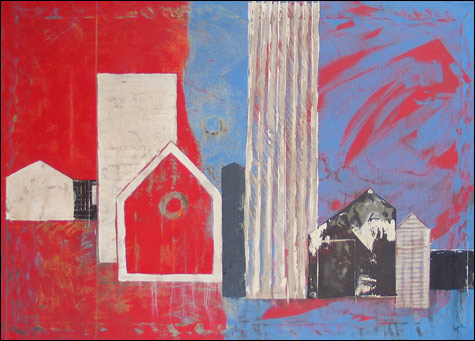
PRIZE OF THE SHOW: Andre LaPorte’s paintings. This is “City #5.” |
The holidaytime group shows in Portland's many galleries are packed with low-hanging fruit of easygoing pieces or copious small works, making yeoman's work for the critic because collections are often without theme or coherence beyond the goal of selling the work. Fortunately, Greenhut Galleries combines the need to roll out the Yuletide roster with an invitation to each artist to celebrate the city of Portland for the fourth biennial Portland Show. With this broad mandate, the modes of creativity throughout the array of artists are quickly apparent.
Tom Hall apologizes in his artist statement, but he needn't. He describes the challenge of painting the city as he is a career landscape painter, but his two small works depicting Fort Gorges and Ricker's Wharf convey a visceral emotion, a precise moodiness characteristic of the city. Nancy Morgan Barnes's "Sky Cam" is another example of injecting a certain quality of place into an otherwise banal scene. Assuredly the perspective from Barnes's rooftop view overlooking the Custom House and the nearby islands is breathtaking, but that alone won't suffice for a good painting. Rather, it's the playful, easy rendering of the blimp floating in the sky, itself with a darkness more mysterious than dreary, that activates the work. The buildings lean toward the viewer in personified playfulness that brings with it the magical qualities of a child's world — a world easy to uncover in Portland with a little dedication.

While Barnes acknowledges the dusty wonderland surrounding Portland's buildings, C. Michael Lewis reveals to us the cold mechanisms of their construction. The vantage point and sweeping ceiling of the Ocean Gateway Terminal in "Tent Building" recall Monet's "Saint-Lazare Station," but the murky ambience of the industrial revolution gives way to a modern matrix of support beams forming a mesmerizing grid. We see only the stark inhumanity of the city in this cavernous structure, with the machines that make it possible in the distance. Each stroke is ultra-vivid and (almost) inhumanly applied such that sky-blues poking through the unfinished roof are arresting in their sharpness.
John Whalley is more than a little precise in his execution as well. The hyper-realist "Portland Glass" is a still life in graphite of an old pharmacist's can and an antique light bulb, both rendered with an unwieldy amount of patience and detail. Whalley always impresses with his attention to an artistic obstacle course of light and reflection, making it seem effortless to capture not only the objects but the aura of their objecthood.
In a group show largely of paintings, Fred Lynch's sculpture "Evergreen 1869" literally pops out. The pathways of an historical period at Evergreen Cemetery are pushed out in relief, formed by wide wooden boards painted white. The result is rough-hewn but comes across as a miniature monument. His approach to the possibilities of pathways literally yields weight, while Alice Spencer's wispy renderings of pastel park paths is more decorative and engaging to a lesser effect. The same goes for Cynthia Davis's painted-on map of the peninsula, overly cerebral and incomplete compared to others of her works in the same vein. For better or for worse, it is noteworthy that all three of these map-oriented artists hang in the back gallery together.
Andre LaPorte is the show-stealer of an exhibition with too many artists to be entirely interesting because of his ability to detect and communicate something intangible about Portland beyond the city's geometries. "Port Nights Quartet" is an interconnected group of four panels representing, in the artist's words, "the high intensity night life being enjoyed by the young of all ages in the OLD PORT'S bawdy BOITES." Feeling explodes out of his kinetic layers without any need for direct representation. This ability is further evidenced in "City #5," which features an abstract skyline with the buildings reduced to their essential forms. Bright reds and blues are endowed humanity by way of abrasions revealing the texture of the canvas. Large white compositional fields become structural as spackled, heavy daubs mixed with the earthy grime of the workshop. The shapes are groundless but the street view is implied. Composition is perfectly balanced as the tall skyscraper encompassing the vertical aspect of the work is deflected from remaining in the limelight by eye-catching circle shapes seemingly burned into the piece. The intentionality of the work has the effortless air of good design with the emotional warmth of the empathetic eye, and is the prize of the show by a long shot.
Ian Paige can be reached at ianpaige@gmail.com.
"4TH BIENNIAL PORTLAND SHOW" through January 3, 2009 | at Greenhut Galleries, 146 Middle St, Portland | 207.772.2693